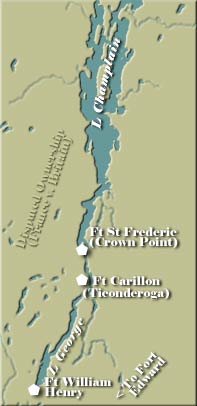Crown Point
In the years between 1731 and 1734, the French constructed a fort at the south end of Lake Champlain in present-day northern New York, near the border with Vermont. Situated on a peninsula called Point à la Couronne (Crown Point* in English), the new installation was named Fort Saint-Frédéric and was intended to protect the southern reaches of New France from British colonial expansion. The structure was remodeled and enlarged several times, and by the mid-1740s stood as an imposing stone fortress.
During the 1750s, as part of the French and Indian War, Crown Point and neighboring installations were the targets of five efforts by the British to wrest control of Lake Champlain from the French.
- The Battle of Lake George (1755). General William Johnson assembled a force of 3,500 men, mostly colonial militia from New England and New York, and marched north with the eventual goal of capturing Fort Saint-Frédéric. Any element of surprise the British had anticipated was dashed by the French discovery of English plans left behind after the defeat of Edward Braddock near Fort Duquesne in July. French commander Baron Dieskau departed from Saint-Frédéric in September and engaged Johnson’s army at the south end of Lac du Saint-Sacrement, the body of water the British preferred to call Lake George. Johnson won a signal victory — one of the few in the conflict's early years — but gave up on his plan to attack Saint-Frédéric. Instead, he concentrated on the construction of Fort William Henry. George II gratefully made Johnson a baron and appointed him Sole Superintendent of Indian Affairs in the area.

- The Stalled Winslow Offensive (1756). The following year, a new British force under John Winslow prepared for a second effort to take Fort Saint-Frédéric. However, before the offensive got underway, word arrived of the French victory at Fort Oswego. The British feared that an overwhelming French army would be assembled in the Champlain Valley, and cancelled their plans.
- The Webb Offensive (1757). In the summer of 1757, the timid General Daniel Webb was disheartened from attempting to extend British control on the lakes when he learned that a large force under the Marquis de Montcalm was moving from Fort Saint-Frédéric toward Fort William Henry. Webb departed for the safety of Fort Edward and the remaining British army was defeated by the French in the William Henry Massacre (August 10).
- The Abercromby Failure (1758). The fourth attempt was made by General James Abercromby, who headed a combined army of nearly 14,000 men. His senseless assault on Fort Saint-Frédéric in July was repulsed and the British force retreated.
- The Amherst Triumph (1759). The French had ample warning of the British offensive in 1759, but were weakened by the reassignment of Montcalm to the defense of Québec. British General Jeffrey Amherst, the hero of Louisbourg a year earlier, was considerably more talented than his predecessors. The French carefully evaluated the threat and decided to evacuate all civilians from the area and attempted to destroy Carillon and Saint-Frédéric to keep them out of British hands. The triumphant Amherst renamed the former, Fort Ticonderoga, and the latter, Crown Point. The British at this point controlled the southern lakes region, but were unable to pursue the retreating French because of the presence of a small French fleet on Lake Champlain. Amherst put his soldiers to work to reconstruct the captured forts, but those labors prevented the army from rendezvousing with James Wolfe on the St. Lawrence.
Crown Point, initially called Fort Amherst, was constructed near the site of Fort Saint-Frédéric. It became the largest British fort in North America with ramparts reaching 27 feet in height and supporting more than 100 cannon. Work on the fort was never completed.
*Crown Point was captured in May 1775 by American forces during the War for Independence, which provided the rebels with badly needed cannon and ordnance.
See
French and Indian War Timeline.
See also
Indian Wars Time Table.
